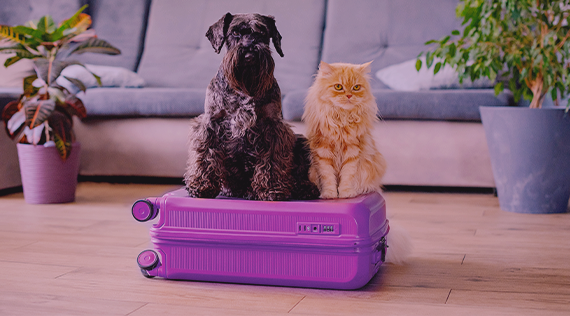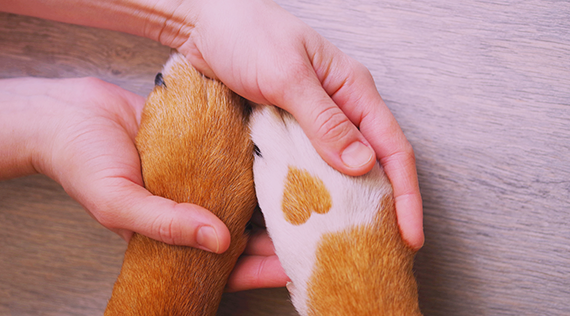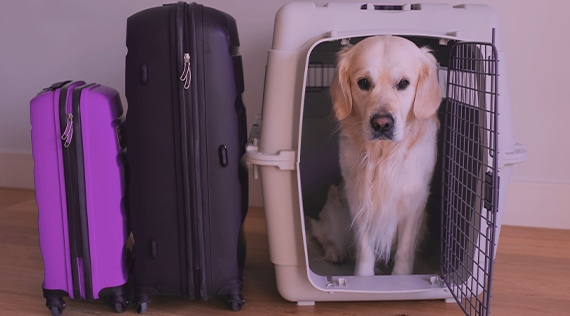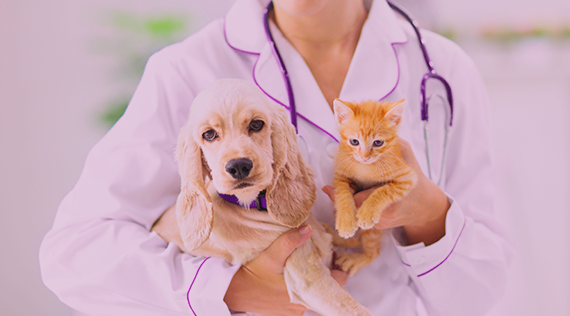
Travel with your pet
Travel with your pet
Fly together to enjoy every moment. Discover everything you need to travel with your pet and live incredible experiences by his side.
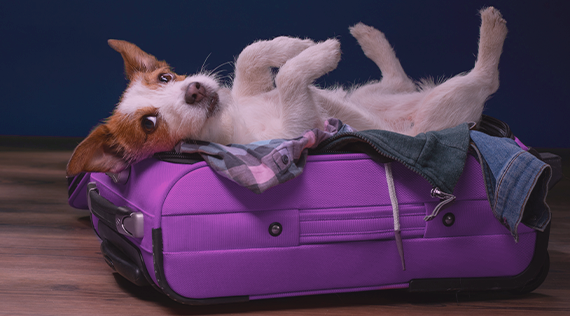
Add the pet service
When booking, on the step of choosing your seat, look for the option “Travel with your pet” and select the desired option: on board or checked.
You can also do this later in My Trips.
Take your four-legged best friend everywhere you go

On board
Fill out the onboard pet form and speed up your passage through the counters.
Container type and size
The container to transport your dog or cat on board can be made of fabric, rigid plastic, or bubble. It must comply with the specified measurements: a maximum of 44 cm long, 30 cm wide, and 19 cm high (17.5 x 12 x 7.5 inches).
Your pet must be able to move within the carrier and weigh up to 26 lb between the container and your pet.
Inside the aircraft
The container must be placed under the seat before you, and the rest of your belongings must be in the overhead bin.
Pets in a stroller
If you travel with a stroller for your pet, it will be charged as additional baggage. The fee will depend on the stroller's size and whether it's considered carry-on or checked baggage.
If checked, you can pick it up at the baggage claim area or the aircraft door, depending on what the customer service agent tells you.
Alternatively, you can replace the baggage included in your reservation (carry-on or checked baggage) with the stroller at no extra cost, as long as it meets the required dimensions.
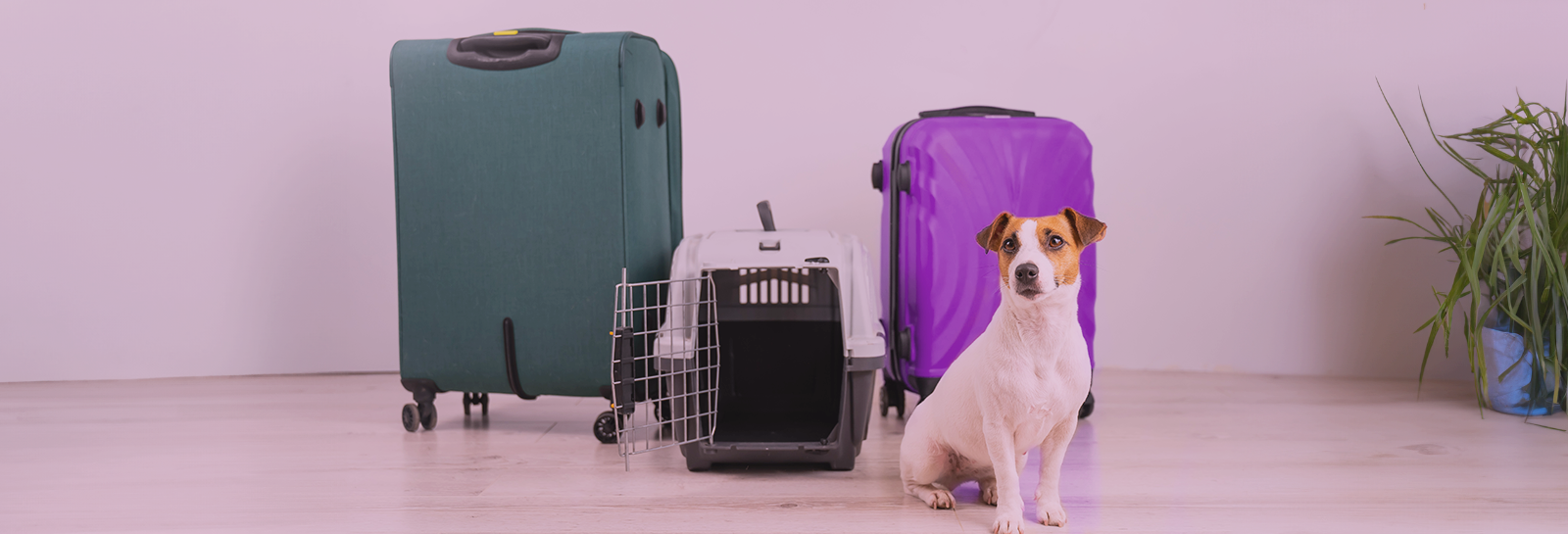
Checked
The combined weight of your pet and the container must not exceed 45 kg (100 lb).
Characteristics
It must be rigid, clean, waterproof, well-ventilated, without wheels, and free of objects that could hurt your pet. It must also be scratch-proof, have an anti-escape closure, and have handles to lift it.
Measurements
Length: should be equivalent to the length of the animal from the tip of the nose to the base of the tail, plus a quarter of that length.
Width: should be equivalent to twice the width of the animal (the widest part of the animal should be taken as a reference).
Height: should be equivalent to the height of the standing animal, from the tip of the head or from the tip of the ears to the ground.
Identification and Contact Information
The carrier must contain your contact information (name, phone, and address) and pet identification (name, age, and sex).
Note: If your pet is traveling documented, it is important that you pick it up as soon as possible at the baggage claim belts upon arrival of your flight.
At Volaris, we strive to care for pets with the same dedication we give to our customers. We understand that long trips can be challenging and, in some cases, stressful for pets. That's why, before planning your flight, we recommend considering whether your pet must join you on this journey.
Get them ready for their flight
Keep in mind these recommendations to make your friend's trip as comfortable as possible, regardless of whether he travels in the cabin or in checked baggage:
Brachycephalic and small breeds
For pet safety, air travel is not recommended for brachycephalic or small breeds since their physiognomy makes them susceptible to illness during the flight.
If you want to take it on board or checked, you must sign a liability waiver letter that we will give you at our counters.
Brachycephalic dogs: Affenpinscher, American Staffordshire Terrier, Boston Terrier, Boxer (all breeds), Bulldog, Cane Corso, Chow Chow, Dogue de Bordeaux, English Toy Spaniel, Brussels Griffon, Japanese Chin, Lhasa Apso, Mastiff, Pekinese, Pit Bull, Presa Canario, Pug (all breeds), Sharpei, Shih Tzu, Tibetan Spaniel, and Staffordshire Bull Terrier.
Brachycephalic cats: Burmese, Exotic Shorthair, Himalayan, and Persian.
Small dogs: Australian Silky Terrier, Beagle, Bichon Frise, Chihuahua (all breeds), Toy Fox Terrier, French Poodle, Schnauzer, Yorkshire Terrier, and Dachshund (wiener dog).

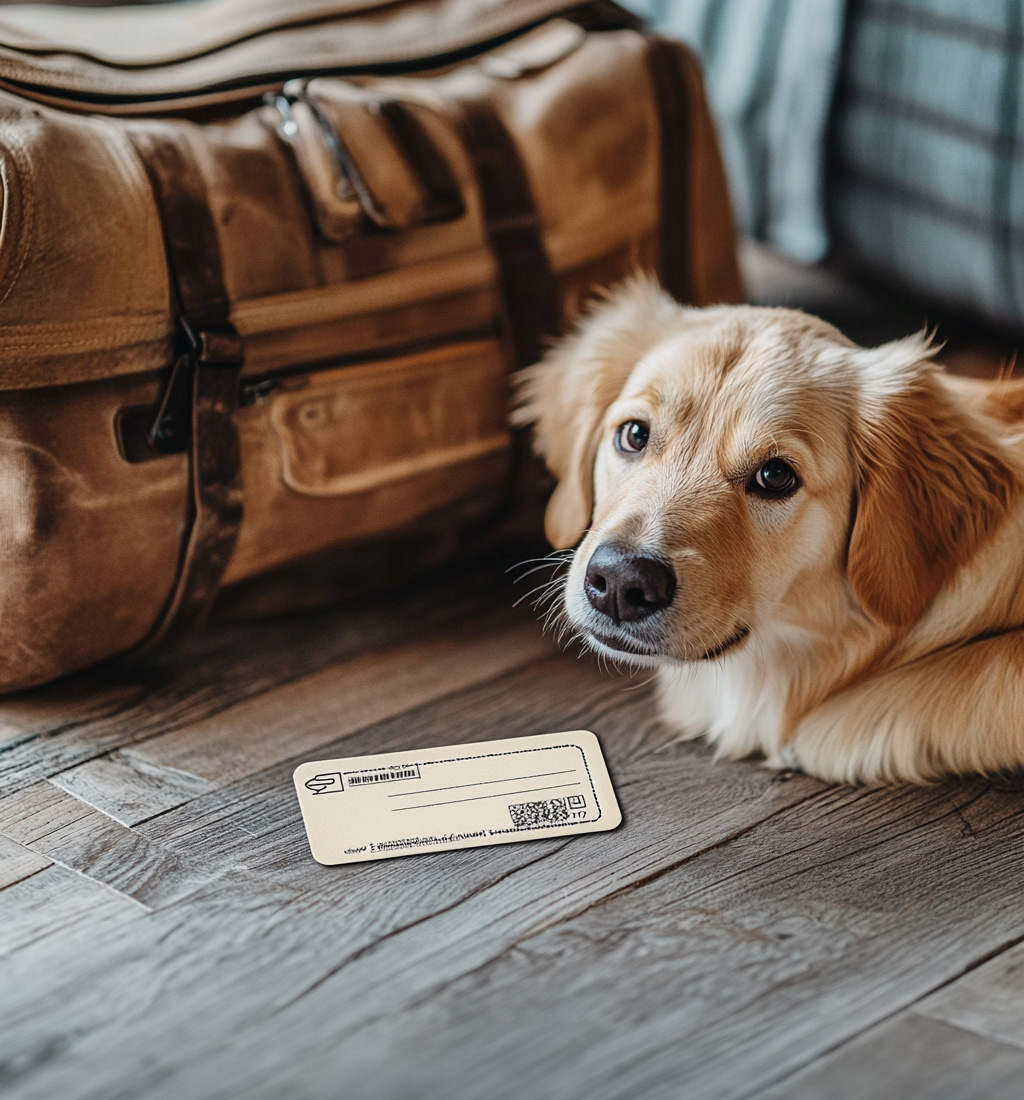
Documents required to travel with your pet
Report to our counters at least two hours in advance for domestic flights and three hours in advance for international flights to verify compliance with travel requirements:
- Present the documents to our customer service ambassadors.
- Fill out the required form with your and your pet's information.
- Pay the transportation fee, if you did not do it online.
Note: Airport security personnel may require an additional inspection of your pet and its container. This process is beyond the control of Volaris, but we recommend you arrive well in advance.
Domestic travel within Mexico
You must present the vaccination booklet that includes the first application of the rabies vaccine or current booster (it can be valid for 1, 2, or up to 3 years).
If your pet is receiving the rabies vaccine for the first time, it must be applied at least 30 days before your travel date.
If your pet is 15 months of age or older, it must have a current rabies booster to travel without waiting 30 days.
It is also essential that your pet has a current deworming (not older than 6 months taking into account the date of return).
Fill out the pet travel form and expedite your passage through the counters.
If traveling to Mexico from Central and South America, you must have the Animal Health Certificate.
Travel to the USA
Remember that all dogs must be free from external parasites, including screwworms (Cochliomyia hominivorax).
Dogs that have been in a high-risk country for canine rabies in the last 6 months (El Salvador, Guatemala, Peru, Colombia, Honduras) must comply with the following additional documents:
- 6 months of age.
- A microchip that can be detected with a universal scanner.
- Healthy appearance upon arrival.
- Receipt of confirmation of the CDC Dog Import Form.
- Certification of U.S.-Issued Rabies Vaccine or a USDA-endorsed export health certificate.
- Vaccination Card.
- Fill out the Pet Travel Form and expedite your passage through the counters.
See here the travel checklist for vaccinated dogs in the USA.
Remember that all dogs must be free from external parasites, including screwworms (Cochliomyia hominivorax).
Dogs that have been in a high-risk country for canine rabies (El Salvador, Guatemala, Peru, Colombia, Honduras) in the last 6 months must comply with the following:
- 6 months of age.
- A microchip that can be detected with a universal scanner.
- Healthy appearance upon arrival.
- Receipt of confirmation of the CDC Dog Import Form.
- Certification of Foreign Rabies Vaccination and Microchip
- Valid rabies serologic titer or a reservation for a 28-day quarantine at a CDC-registered animal care facility.
- Reservation at a CDC-registered Animal Care Center for examination and revaccination (and quarantine if the dog does not have a valid rabies serologic titer).
- International flights arrive directly at the airport with the CDC-registered animal care facility where the dog is booked (Miami (MIA), New York (JFK), Los Angeles (LAX), or Washington (IAD)).
- Vaccination Card
- Fill out the Pet Travel Form and speed up your time at the ticket counter.
See here the travel checklist for vaccinated dogs outside the USA.
Remember that all dogs must be free from external parasites, including screwworms (Cochliomyia hominivorax).
Dogs that have been in a low-risk country for canine rabies (Mexico and Costa Rica) within the last 6 months.
- 6 months of age at the time of entry or return to the United States.
- A microchip that can be detected with a universal scanner.
- Healthy appearance upon arrival.
- Receipt of confirmation of the CDC Dog Import Form (This confirmation arrives in the mail registered in the CDC Dog Import Form).
- Arrive at the airport declared in the CDC Dog Import Form.
- Vaccination Card.
- Fill out the Pet Travel Form and expedite your passage through the counters.
Travel to Central and South America
Vaccination Card:
You must present the vaccination booklet that includes the first application of the current rabies vaccine or booster (which can be valid for 1, 2, or up to 3 years).
If your pet is receiving the rabies vaccine for the first time, it must be applied at least 30 days before the date of your trip.
If your pet is 15 months of age or older, it must have a current rabies booster to travel without waiting 30 days.
It is also indispensable that your pet has a current deworming (not older than 6 months taking into account the date of return).
The following vaccinations must be included in the vaccination record:
- Dogs: rabies, distemper or distemper, adenovirus or hepatitis, parvovirus, parainfluenza, and leptospirosis.
- Cats: rabies, viral rhinotracheitis, calicivirus, feline panleukopenia, and feline viral leukemia.
Note: If your dog or cat does not have the leptospirosis vaccine, you can apply it upon arrival at the airport in Honduras covering the corresponding cost.
Both dogs and cats must be dewormed for no more than 6 months.
Additional information: upon arrival in Honduras, the Agricultural Health personnel (OIRSA) will inspect your pet and you will have to pay the corresponding fee.
Zoosanitary Certificate:
You must show an International Animal Health Export Certificate issued by SAGARPA/SENASICA/SENASA/CENTREX.
Vaccination Card:
You must present the vaccination booklet that includes the first application of the current rabies vaccine or booster (which can be valid for 1, 2, or up to 3 years).
If your pet is receiving the rabies vaccine for the first time, it must be applied at least 30 days before the date of your trip.
If your pet is 15 months of age or older, it must have a current rabies booster to travel without waiting 30 days.
It is also indispensable that your pet has a current deworming (not older than 6 months taking into account the date of return).
The following vaccinations must be included in the vaccination record:
- Dogs: parvovirus, distemper, hepatitis, leptospira, parainfluenza and rabies.
- Cats: feline panleukopenia and rabies.
Both dogs and cats must have deworming (internal and external) performed within 15 days prior to travel.
Zoosanitary Certificate:
Upon your arrival in Peru, the personnel of the National Service of Agrarian Health of Peru (SENASA) will ask you for the Zoosanitary Certificate of Export to inspect your pet, and you will have to pay the corresponding fee.
Requirements and restrictions
- Only dogs and cats are allowed.
- Pets under 4 months old, sick, dead, violent, or pregnant females are not allowed.
- You can bring only one animal per container.
- Do not subject your pet to surgical processes within 5 days prior to the flight.
- On board and checked pet services are not available for Frontier-operated flights, whether direct or connecting.
- Dogs may travel in any window seat, except premium and emergency exit. Cats only in the last row window.
Dogs of breeds considered dangerous or aggressive cannot travel either as pets on board or checked: Pit Bull (all breeds), Staffordshire Terrier, American Staffordshire Terrier, Shar Pei, Boxer (all breeds), Bull Terrier, American Bulldog, Bullmastiff, Akita Inu, Dogo Argentino, Fila Brasileiro, Anatolian Shepherd, Doberman, Rottweiler, Japanese Tosa, Dogue de Bordeaux, Akita Americano, Neapolitan Mastiff, Presa Canario, German Shepherd, and Italian Mastiff.
You can purchase the service when you buy your flights on our website, the app, at the airport counters, or by calling our Call Center.
Requirements by country of origin: Check the SENASICA requirements to import animals into Mexico, depending on their country of origin and provenance.
SENASICA: Check the SAGARPA-SENASICA requirements to bring pets (dogs and cats only) into Mexico.
Centers of Disease Control: Consult the U.S. government regulations for bringing animals into Mexico.






